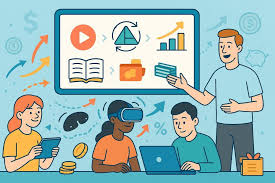In today’s digital age, the role of a teacher has evolved beyond traditional classroom instruction. Modern educators are increasingly incorporating kids animated shows into their teaching methods, recognizing the powerful impact these visual storytelling mediums can have on young minds. The colorful characters and engaging narratives of animated content capture children’s attention in ways that conventional teaching methods sometimes struggle to achieve, making complex concepts more accessible and memorable.
Educators across the country report significant improvements in student engagement when lesson plans incorporate elements from popular animations. For instance, math concepts become less intimidating when presented through the adventures of characters children already know and love. Science lessons take on new dimensions when illustrated through the vibrant worlds of animation. This strategic integration represents a shift in educational philosophy, acknowledging that learning happens most effectively when children are emotionally invested in the material.
The marriage between education and entertainment isn’t entirely new, but the sophistication with which modern teachers are approaching this integration deserves attention. Professional development workshops now frequently include sessions on media literacy and how to effectively incorporate digital content into curriculum design. Educational psychologists point to the multisensory nature of animated content as particularly beneficial for knowledge retention and concept formation in developing brains.
Research from the Educational Technology Institute suggests that students retain information approximately 65% more effectively when it’s presented alongside visual narratives they connect with emotionally. This statistic hasn’t gone unnoticed by curriculum designers and education policy experts, who are increasingly advocating for more flexible approaches to classroom resources. The rigid textbook-only approach is gradually giving way to more dynamic, multimedia-rich educational environments.
Teachers who successfully implement animated content in their classrooms often follow certain best practices. They carefully select shows that align with specific learning objectives rather than using animation as mere entertainment. They prepare guided viewing questions that direct students’ attention to relevant themes or concepts. Follow-up activities then build upon the viewed content, reinforcing the educational takeaways through discussion, creative projects, or problem-solving exercises.
The benefits extend beyond academic learning. Social-emotional development—increasingly recognized as crucial to educational success—receives powerful support through carefully selected animated content. Shows that model conflict resolution, emotional regulation, and positive social interactions provide teachers with valuable reference points when addressing behavioral challenges in the classroom. “Remember how Character X handled disappointment?” becomes a shorthand prompt for guiding students through similar emotional situations.
Critics occasionally voice concerns about screen time replacing more traditional learning activities. However, proponents argue that quality matters more than quantity, and that thoughtfully integrated animated content serves as a supplement to, rather than replacement for, other educational approaches. The key lies in intentional selection and implementation, treating animated shows as tools within a broader pedagogical strategy rather than standalone solutions.
Teacher preparation programs at forward-thinking universities have begun incorporating media literacy components into their curriculum, ensuring that new educators enter the profession equipped to navigate the digital landscape alongside their students. This represents an acknowledgment that today’s teachers must be fluent not only in their subject matter but also in the cultural and media environments that shape their students’ worldviews.
As we look toward the future of education, the relationship between teachers and animated content will likely grow more sophisticated. Personalized learning platforms are already beginning to incorporate adaptive animated elements that respond to individual students’ progress and learning styles. Virtual reality educational experiences, still in their infancy, promise to further blur the line between animation and immersive learning experiences.
The most successful educational approaches will likely continue to balance technological innovation with the irreplaceable human element that skilled teachers bring to the classroom. Animation and other digital tools may enhance engagement and provide new avenues for concept explanation, but the teacher’s role in facilitating discussion, providing feedback, and nurturing critical thinking remains paramount. In this evolving educational landscape, the thoughtful integration of animated content represents not a replacement of traditional teaching but an expansion of the teacher’s toolkit.

